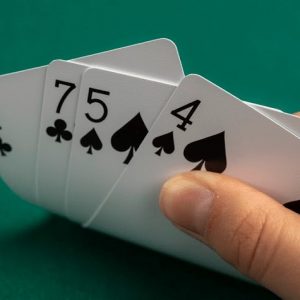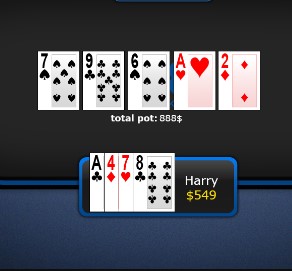Playing A-4 and A-5 in Omaha Hi Lo

If you look at strategy for Omaha Hi-Lo, you’ll find a lot about playing A-2 and A-3 starting hands, but not a lot about A-4 and A-5 starting hands.
While starting hands with A-4 as the key cards are not as advantageous as playing A-2, and A-3, they shouldn’t be overlooked entirely. Today, let’s look at playing A-4 and A-5 starting hands in Omaha Hi-Lo.
Uncoordinated A-4 and A-5
Starting hands that should largely be avoided are A-4 and A-5 hands without any coordination. For example, As-4c-7h-10d is an example that is too uncoordinated of a hand to really play. There are some that would play this in the small blind but you are hoping for a miracle board to give you any chance of winning.
Coordinated But Unsuited
Next comes A-4 and A-5 hands that are unsuited but coordinated. For example, As-4c-Kd-Jh. These are hands that have some reasonable high capabilities and some reasonable low chances. This is a hand that you would play in the blinds or in a pot with a lot of limpers. You’ll need to be careful of flush draws and paired boards to continue with this past the flop.
Three Low Cards
You’ll see a lot of A-4-5, A-4-6, A-5-6, and A-5-7 types of hands that you will want to play. However, these are hands you don’t want to play too aggressively outside of the blinds. Family pots may be OK but you have to be careful to avoid non-nut hands and second-best lows.
Suited and Coordinated
Your best options are where your hands are both suited and coordinated. Ah-4h-Jd-10c is a good hand example. When we talk about suited and coordinated, we are more concerned about the ace being suited. Your coordinated cards being suited are not as important as you will have a hard time making the nuts with these hands.

You might call a single raise with these hands, but only because you have multiple opportunities. This is not a hand you want to call a lot of action with.
Deuce or Three on Flop or Dump
A rule of thumb that I like to use with A-4 and A-5 hands is that I have to see a 2 or 3 on the flop or I am dumping the hand in most cases. The exception is where I flop a nut straight or flush draw. However, if one of my required cards to make nut low does not hit the flop, I need a nut high draw to stay. Otherwise, I am getting out of the hand on the flop.
Don’t Be Afraid to Bet Low if A-2 Counterfeits
There are times where you’re going to have hands like A-4-6-10 that will make an oddball or even an emergency low. If the flop falls A-5-7, you have a pair of aces and a weak low. However, there are many times that your opponent was just counterfeited. When this happens, it cannot hurt to put out a bet to try and take the pot.
In this example, you have a weak low but also an open-ended draw to a straight. At worst, you’re semi-bluffing. However, a hand like A-2-9-10 is going to be hard-pressed to call your bet. If they don’t improve on the turn, you will probably knock them out of the pot.
A-4 and A-5 Are Not Action Hands Pre-Flop
We will stress yet again that A-4 and A-5 hands are not ones that you want to play to a lot of action pre-flop. These are hands you want to see a cheap flop with and hope to catch up. They are not strong enough to make or call raises pre-flop.
The key to playing these hands is to get in the pot cheap and avoid pitfalls associated with second-best hands. When played skillfully, these hands can make you money.
